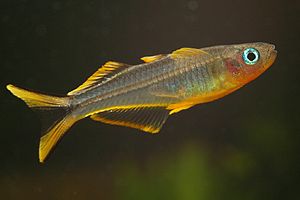Fork-tailed blue-eye
| Fork-tailed blue-eye | ||||||||||||
|---|---|---|---|---|---|---|---|---|---|---|---|---|

male |
||||||||||||
| Systematics | ||||||||||||
|
||||||||||||
| Scientific name | ||||||||||||
| Pseudomugil furcatus | ||||||||||||
| Nichols , 1955 |
The fork-tailed blue-eye ( Pseudomugil furcatus , syn .: Popondichthys furcatus ), also called the fork-tailed rainbow fish , belongs to the blue-eyed family , which was formerly a subfamily of the rainbow fish. Its average size is 4.5 to 6 cm.
Labelling
The fish of the genus show clearly pronounced sexual dimorphism . The elongated, yellowish-transparent fork-tailed blue eyes have a body length of 5 to 6 cm, the females remain somewhat smaller. In addition to the striking blue eyes, the yellow fins and the yellow-orange breast are typical features. The yellowish caudal fin with outer, black stripes is relatively strongly forked for blue eyes. The males can be easily distinguished from the females from an age of six months due to their more intense coloration and the elongated dorsal fin.
The fork-tailed blue-eye is often confused with the closely related species Pseudomugil connieae , but differs from this and others. a. through the black-lined caudal fin.
Occurrence
The species is native to the southeast of the city of Popondetta in the coastal plains and the subsequent lowlands of Papua New Guinea between Dyke Ackland Bay and Collingwood Bay. The fork-tailed blue-eye was originally discovered in a tributary of the Kwagira (Kwagila) River in eastern Papua New Guinea. In Safia, in the valley of the Musa River, they were found relatively frequently in small, clear rainforest streams. They prefer moderately flowing waters with temperatures of 24 to 28.5 ° C and pH values of 7.0 to 8.0 with lush underwater vegetation.
Systematics
The species was first collected by Hobart M. Van Deusen during the 4th Archbold Expedition in New Guinea on August 24, 1953 and described by Nichols in 1955 as Pseudomugil furcatus . In a revision of the rainbow fish family in 1980, they were separated from the genus Pseudomugil and placed in the new genus Popondetta . Since the name was already used for a genus of beetles, the genus name had to be changed to Popondichthys in 1987 . After another revision of the Blue Eyes family in 1989, they are today again carried under their original name.
In the aquarium
The fork-tailed blue-eye is easy to keep and multiply in the aquarium . It feels good at temperatures between 22 and 26 ° C and needs a pH value between 7 and 8 for medium-hard water. Due to their ability to swim, the aquarium should hold at least 60 - better 100 liters of water. A group of around six to ten individuals should always be kept.
When properly fed with frozen or live food, the females of the fork-tailed blue-eyes lay few eggs with adhesive threads on plants or in gravel. The fry hatch after two to three weeks. They should be separated from their parents as they will eat their offspring. The young can be raised with infusoria , Artemia nauplii or powdered food.
Individual evidence
- ↑ Nichols, JT (1955) Results of the Archbold expeditions . No. 71. Two new fresh-water fishes from New Guinea. American Museum Novitates 1735, pp. 1-6. (First scientific description)
- ↑ Gerald R. Allen: A Generic Classification of the Rainbowfishes (Family Melanotaeniidae) . In: Records of the Western Australian Museum . 8, No. 3, 1980, pp. 449-490.
- ^ B. Crockford: The genus Popondetta . In: Fishes of Sahul . 2, No. 2, 1984, pp. 66-68.
- ^ B. Saeed, W. Ivantsoff, GR Allen: Taxonomic revision of the family Pseudomugilidae (Order Atheriniformes) . In: Australian Journal of Marine and Freshwater Research . 40, 1989, pp. 719-787.
- ↑ Dirk Godlinski: Pseudomugil furcatus - butterflies for the aquarium . In: The aquarium and terrarium magazine . tape 62 , no. 6 , 2009, ISSN 1616-3222 , p. 36-37 .
Web links
- Pseudomugil furcatus by Adrian Tappin (English)
- Fork-tail blue-eye on Fishbase.org (English)
- Pseudomugil furcatus inthe IUCN 2013 Red List of Threatened Species . Posted by: Allen, G., 1996. Retrieved January 11, 2014.
